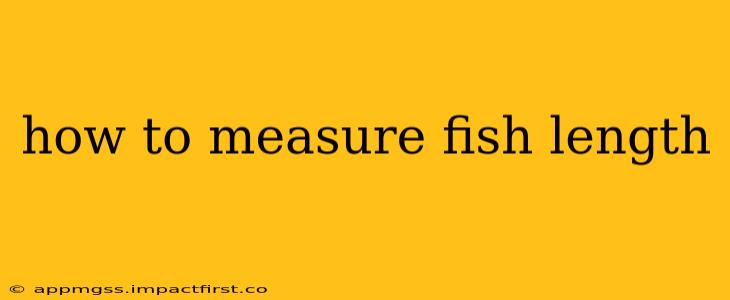Measuring fish length accurately is crucial for various purposes, from recreational fishing and catch-and-release programs to scientific research and fisheries management. Inaccurate measurements can skew data, impacting conservation efforts and our understanding of fish populations. This guide will walk you through the proper methods for measuring fish length, addressing common questions and potential pitfalls.
What is the Standard Method for Measuring Fish Length?
The standard method for measuring fish length is total length. This measurement is taken from the most anterior point of the snout (the tip of the upper jaw) to the most posterior point of the caudal fin (the end of the tail fin), keeping the fish lying straight. It's important to ensure the fish is lying flat and extended naturally – avoid forcing it into a position that alters its length.
Tools Needed for Accurate Measurement:
- A rigid measuring board or ruler: Flexible rulers can lead to inaccurate measurements. A measuring board with a flat surface is ideal.
- A pen or pencil: To mark the measurements for easy reading.
- Gloves (optional): Protect yourself and the fish, especially if handling multiple specimens.
How to Measure Fish Length Step-by-Step:
- Prepare the Fish: Gently lay the fish on a flat surface, ensuring it’s straight and its body is not bent or curved.
- Align the Ruler: Place the measuring board or ruler alongside the fish, aligning the zero mark with the most anterior point of the snout.
- Extend to the Tail: Extend the ruler to the most posterior point of the caudal fin.
- Record the Measurement: Note the measurement precisely, recording it to the nearest millimeter or quarter-inch, depending on your chosen unit of measurement.
What About Fork Length?
While total length is the most commonly used measurement, fork length is sometimes employed, particularly for certain fish species. Fork length is measured from the tip of the snout to the fork of the caudal fin (the point where the two lobes of the tail fin separate). Fork length is usually shorter than total length. Always clarify which measurement is being used when reporting your findings.
How to Measure Fish Length Accurately in Different Situations:
Measuring Small Fish:
For smaller fish, use a ruler with finer graduations (millimeters) and take extra care to avoid bending or damaging the fish during measurement. Consider using a clear plastic ruler to facilitate accurate measurement.
Measuring Large Fish:
Measuring large fish can be challenging. Use a longer measuring board or tape measure designed for this purpose. Two people might be needed to hold the fish steady and take the measurement.
Why is Accurate Fish Length Measurement Important?
Accurate fish length measurements are vital for several reasons:
- Fisheries Management: Length data contributes to assessing fish populations, determining growth rates, and setting appropriate fishing regulations.
- Scientific Research: Accurate measurements are essential for biological studies, analyzing fish growth patterns, and identifying species.
- Catch and Release: Monitoring fish length in catch-and-release programs helps assess the health of fish populations and the effectiveness of conservation efforts.
- Recreational Fishing: Accurate measurements can contribute to personal records and tournament competitions.
What are the potential sources of error in measuring fish length?
Several factors can lead to inaccurate measurements:
- Improper handling: Bending or flexing the fish's body during measurement.
- Using a flexible ruler: Leads to inaccurate estimations of the actual length.
- Incorrect alignment: Not aligning the ruler correctly with the snout and caudal fin.
- Observer bias: Subtle variations in how the measurement is taken can lead to discrepancies.
By following these guidelines and understanding potential sources of error, you can ensure the accuracy of your fish length measurements, contributing valuable data to various fields and improving our understanding of aquatic ecosystems. Remember always to handle fish with care and follow any specific regulations related to measuring fish in your area.
